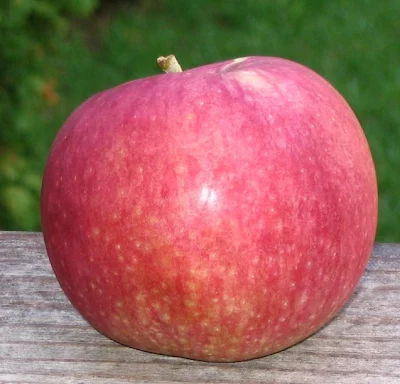 |
Perhaps the most famous, familiar, and popular of Northeastern apples. Available year-round, though quality varies. Also known as "Mac."
They even named a computer after it (misspelling the name).
McIntosh is generally medium-sized and nearly perfectly round, though some show a little ribbing. Its attractive crimson blush can be streaky and is accented with light spots that are larger than most.
The flesh is fine-grained, juicy, and white, sometimes with green highlights. It is reasonably crisp and firm though yielding.
McIntosh's superb flavor is tart balanced with sweet, with some acidity and a mix of berry and spice. There are hints of melon and zinc, and the skin is on the chewy side.
The net effect is greater than the sum of the parts of this description. Some describe the result as vinous (as in wine).
 Many sources agree the McIntosh was discovered by John McIntosh on his farm in Ontario in 1811. O, Canada!
Many sources agree the McIntosh was discovered by John McIntosh on his farm in Ontario in 1811. O, Canada!
The Mac is the sire of many other varieties, including Macoun, Spencer, Empire, Spartan, and Cortland.

I tried my first McIntosh today. These were on sale at the grocery store. They were marked as coming from New York. The apple was very round and dark red. The flesh was firm to crisp and breaking with a nice amount of juice. The flesh was white and had a blanance of sweet and acid (mostly sweet). The flavor was berry like and vinous. A nice apple to enjoy on a snowy day in Wisconsin!
ReplyDeleteMatt, these are such mainstays in the Northeast I am always surprised when someone says they've never had one before.
DeleteMcIntosh and its kin are fragile and by February can be less than perfectly crisp, so I am glad you got a good one on that score.
Even a well-kept sample will have lost some flavor by now, so if you liked yours try one off the tree sometime!
I have had a Macoun right off the tree in Wisconsin in the past and they have been great!
ReplyDeleteHave you ever herd of an sunrise apple? It's a early season McIntosh variety. It's a cross between a McIntosh x Golden Delicious.
ReplyDeleteInfo: http://www.nsapples.com/cultivar/index.htm
Byron, I have heard of this one, but never had the pleasure.
DeleteIt does seem to me that the niche for early apples like this one is relatively uncluttered.
We get them once and awhile. It is good. I hope you get to try it. Though I still think nothing beats a McIntosh. I still remember taking field trip down to the valley to go apple picking. Picked two burlap bags full of McIntosh. I had McIntosh for weeks and all I paid was $2.00 for the bus. Good times.
DeleteByron, what a great story. McIntosh will always be one of the classics for me.
DeleteI've had many McIntosh apples over the years, but until last year never saw one with pink flesh. I think that specimen was the best I've had.
ReplyDeleteSometimes an apple that is allowed to ripen long on the tree will get so much blush that the pigment bleeds into the flesh. Is that what you are describing?
DeleteI have never seen it with a mac, but am sure it happens.
Could be, but I think it penetrated pretty far. I've got a cultivar that I believe is half Mac and it too turns pink some years.
DeleteWe used to get McIntosh apples in CA supermarkets when I was a child in the 1970s, I haven't seen them in many years in the Los Angeles and Ventura County areas. Too bad. My grandparents liked this apple best. I do recall them having sometimes a "mealy", grainy texture, but flavorful.
ReplyDeleteI hardly ever see them anymore either. The last time was a few years back, when there were some at a Safeway here in Fairbanks, Alaska. I think they're mostly grown back east, especially where winter hardiness is necessary.
Delete@Anon: These are not mealy when fresh! but are also not especially good keepers, and need good handling if they are to travel (say, to LA). That may have been an on-again, off-again thing in the 70s.
Delete@Vic, I suspect McIntosh is becoming a regional treat here, as growers are chasing national trends.
So, not as many Mac trees, for one thing.